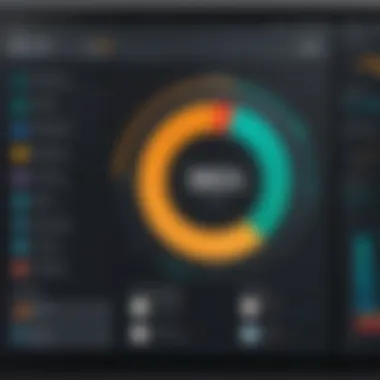Microsoft Dynamics Retail Management System: A Deep Dive


Intro
The Microsoft Dynamics Retail Management System (RMS) stands as a robust software solution designed to address modern retail challenges. This system has gained traction among retailers seeking to optimize their operations and enhance customer engagement. Through its various functionalities, it enables businesses to offer tailored experiences while maintaining efficient process management. This article will provide an in-depth analysis of Microsoft Dynamics RMS, exploring its essential features, installation procedures, and overall impact on the retail landscape.
Software Overview
Purpose and Function of the Software
Microsoft Dynamics RMS serves as a comprehensive tool for retail management. Its primary purpose is to streamline operations, enhance customer interactions, and offer insights through robust reporting capabilities. The system enables retailers to manage sales, inventory, and customer relationships effectively. It supports multiple retail channels, including brick-and-mortar stores and e-commerce platforms, providing flexibility in operations.
Key Features and Benefits
The software boasts several key features that elevate it above traditional retail management tools:
- Inventory Management: Track stock levels in real-time, ensuring you have the right products available when customers need them.
- Sales Processing: Efficiently manage sales transactions with a user-friendly interface that reduces checkout times.
- Customer Relationship Management: Maintain detailed customer profiles to personalize marketing efforts and improve loyalty.
- Reporting and Analytics: Generate insightful reports to analyze sales trends, customer preferences, and inventory performance.
- Integration Capabilities: Seamlessly connect with other Microsoft services, such as Office 365 and Dynamics CRM, enhancing overall functionality.
The Microsoft Dynamics Retail Management System is not merely a tool but a comprehensive platform helping businesses thrive in a competitive market.
The advantages of employing Microsoft Dynamics RMS include improved operational efficiency, enhanced customer satisfaction, and the ability to make informed decisions based on data-driven insights.
Installation and Setup
System Requirements
Before installing Microsoft Dynamics RMS, it is essential to ensure that your system meets the necessary requirements. These typically include:
- Operating System: Windows 10 or later versions
- Processor: Minimum dual-core processor
- RAM: At least 8 GB recommended
- Hard Disk: Sufficient disk space for installation and operation
- Network: Stable internet connection for online features and updates
Installation Process
To install Microsoft Dynamics RMS, follow these steps:
- Download the software from the official Microsoft website.
- Run the installation setup file and follow the on-screen instructions.
- Accept the license agreement and select the installation location.
- Configure the initial settings, including user accounts and security permissions.
- Complete the installation and restart the system if prompted.
Once installed, users can begin exploring the features and customizing the software to suit their specific retail needs.
Prelude to Microsoft Dynamics
The introduction of Microsoft Dynamics into the retail sector marks a significant leap towards streamlined operations and enhanced customer experiences. Microsoft Dynamics provides a suite of solutions tailored specifically for businesses aiming to elevate their retail management processes. This article will explore how leveraging this powerful system can optimize operations, making it a crucial topic for discussion.
Overview of Microsoft Dynamics
Microsoft Dynamics encompasses various business applications designed to integrate seamlessly into organizational processes. The emphasis on a user-friendly interface and robust functionality ensures that retail businesses can utilize its features with minimal friction. Key modules such as sales, customer service, and financial management work collectively to support retail operations. This integration provides clear visibility and access to critical data, enabling more informed decision-making.
Key features of Microsoft Dynamics include:
- User-Friendly Interface: The intuitive design makes it accessible for users of all technical backgrounds.
- Scalability: As a company grows, Microsoft Dynamics can be adjusted to meet increasing demands and complexities.
- Integration: With numerous third-party applications, it can be tailored to fit specific business needs.
These elements contribute to creating a more cohesive retail environment, driving efficiency and growth.
Importance in Retail Management
The importance of Microsoft Dynamics in retail management cannot be understated. It acts as the backbone for data-driven strategies. One significant aspect is its ability to unify various sales channels, ensuring that all customer interactions, whether in-store or online, are connected. This integration fosters a more comprehensive understanding of customer behavior and preferences.
As businesses face increasing competition, the need for real-time data becomes paramount. Microsoft Dynamics facilitates this by providing near-instant insights into sales trends and customer interactions. Retail managers can assess inventory levels, track purchase patterns, and respond dynamically to changes in consumer demands.
Moreover, the system supports:
- Improved Customer Engagement: By accessing customer history and preferences, retailers can tailor their offerings effectively.
- Streamlined Operations: Automating routine tasks free up staff to focus on higher-value activities.
- Enhanced Reporting Capabilities: By generating detailed reports, businesses can make strategic decisions based on concrete data.
"Understanding the importance of integrated solutions like Microsoft Dynamics is key to achieving success in today’s competitive retail landscape."
In summary, Microsoft Dynamics provides a comprehensive framework for managing retail operations. This foundational understanding sets the stage for a deeper exploration of its core features and functionalities.
Core Features of the Retail Management System


The Core Features of the Retail Management System play a pivotal role in shaping how retail businesses operate in the digital age. Understanding these features aids businesses in selecting and implementing the right tools for their needs.
Point of Sale (POS)
The Point of Sale (POS) component of Microsoft Dynamics is the backbone of retail transactions. It serves not only as a cash register but also as a complete commerce platform. This system allows retailers to process transactions swiftly and efficiently. Key functionalities of the POS include accepting various payment methods - from credit cards to mobile payments - enhancing customer satisfaction through flexible options.
Moreover, real-time inventory check during sales prevents situations where items may appear in stock but are not available. This synchronization reduces customer frustration and improves the overall shopping experience. Additionally, the POS captures valuable sales data, allowing retailers to analyze purchasing patterns and make data-informed decisions about inventory and promotions.
Inventory Management
Inventory Management within the Microsoft Dynamics framework is designed to streamline stock control. This feature offers visibility on stock levels across multiple locations in real-time. Businesses can automate various inventory tasks such as re-ordering and tracking product movements, which minimizes stockouts and overstock situations. This balance is crucial as excess inventory ties up capital, while insufficient stock can lead to lost sales and customer disappointment.
Another benefit of effective inventory management is the ability to integrate with sales forecasts. By analyzing past sales data, retailers can make informed decisions about future inventory needs. In a fast-paced retail environment, aligning inventory with customer demand can significantly boost efficiency and reduce waste.
Customer Relationship Management (CRM)
Customer Relationship Management (CRM) is central to enhancing customer loyalty and engagement. Microsoft Dynamics helps retailers gather and analyze customer data to tailor marketing efforts. Features such as tracking purchase history and preferences allow businesses to implement personalized marketing strategies. Customers are more likely to engage with promotions that align with their interests, which can lead to increased sales volume.
Furthermore, the CRM system can assist in onboarding new customers effectively by capturing valuable data at the first point of interaction. With this information, retailers can shape a more targeted approach, ensuring that customer inquiries are addressed promptly and effectively. Positive interactions foster a loyal customer base, thereby supporting long-term growth.
Data Analytics and Reporting
Data Analytics and Reporting capabilities in Microsoft Dynamics provide insights that drive informed decision-making. Retailers can leverage this feature to analyze sales trends, customer behaviors, and operational efficiency. Automated reporting allows businesses to track performance metrics without manual intervention, saving time and reducing error rates.
Additionally, advanced analytics can uncover patterns that inform strategic decisions. For example, if data indicates that certain products have stronger seasonal sales, retailers can optimize their inventory and marketing efforts accordingly. Data-driven insights can help in predicting future sales, adjusting pricing strategies, or identifying new market opportunities.
"Using data analytics not only improves efficiency but also provides a competitive edge in the highly dynamic retail landscape."
Implementation Strategies
In the context of Microsoft Dynamics Retail Management System, implementation strategies are crucial. The success of a retail management system hinges on its ability to meet specific business needs. A well-crafted implementation strategy ensures that the system is tailored to the unique requirements of a retail operation, enhancing overall efficiency and customer satisfaction.
By focusing on how various components of Microsoft Dynamics interact, companies can achieve a more effective integration into their workflow. These strategies involve several distinct elements including assessment of retail needs, customization, and the training provided for end users.
Assessment of Retail Needs
The first step in any successful implementation is the assessment of retail needs. This involves a thorough analysis of existing processes and pain points within the current system. Feedback from staff and customers should also be taken into account. Clearly identifying these elements helps businesses to gauge what features of Microsoft Dynamics will be most beneficial.
An effective assessment can help to:
- Determine areas for improvement
- Align the system’s functionalities with business objectives
- Identify potential barriers and challenges
Customization and Configuration
Once needs are assessed, the next step is customization and configuration. Microsoft Dynamics is designed to be flexible; It allows retailers to tailor their tools to suit their specific operational goals. This may involve configuring the Point of Sale setups, inventory stock management workflows, and CRM mechanisms.
Moreover, attention should be given to creating a user-friendly interface tailored to different roles within the retail business. Ensuring that the system is configured to streamline operations requires experimenting with different setups, and gathering feedback from users during this process is essential.
Training and Support
Even the most advanced technology can falter without proper training and support. Upon deploying Microsoft Dynamics, a robust training program should be initiated for all end users. This includes ensuring that everyone understands how to utilize each feature effectively from the POS to data analytics tools. Training might take place through workshops or online tutorials.
Support should also be readily available to address any ongoing issues post-implementation. Retailers can benefit from:
- Ongoing technical support
- Regular updates and training sessions
- Access to a community of users for shared insights and problem-solving
"Proper implementation strategies are not just about installing software; it is about ensuring that the system works as intended within the unique landscape of the retail business."
Integration with Other Systems
Integration with other systems is a critical aspect of the Microsoft Dynamics Retail Management System. This functionality fosters seamless communication between various business applications, enabling organizations to operate more efficiently. Integration ensures that data flows freely across systems, which helps in minimizing manual data entry and reducing the possibility of errors.
The ability to connect with different platforms allows retailers to create a cohesive technology ecosystem that leverages the strengths of each application. Whether it involves customer relationship management systems, e-commerce platforms, or supply chain management solutions, effective integration provides businesses with significant advantages.
ERP Integration


Enterprise Resource Planning (ERP) integration is vital for retailers using Microsoft Dynamics. This type of integration enables a comprehensive view of the business by linking finance, inventory, and human resources data. By connecting the retail management system with an ERP solution, businesses can streamline operations. They can ensure consistent data across departments, allowing for quicker decision-making.
Key benefits of ERP integration include:
- Data Accuracy: Reduces human errors related to manual data entry.
- Real-Time Updates: Allows businesses to react swiftly to changes in inventory or sales.
- Improved Forecasting: Provides insights necessary for future planning and demand forecasting.
This connection ultimately enhances operational efficiency, reducing costs and improving overall performance. Retailers must assess their ERP options carefully to determine the best fit for their existing systems.
E-commerce Platforms
Integration with e-commerce platforms is essential for retailers looking to expand their reach and provide customers with a unified shopping experience. Microsoft Dynamics can connect with various popular platforms, such as Shopify and Magento. This integration enables retailers to manage online and offline sales consistently.
Some advantages include:
- Consolidated Customer Data: Having a single view of customer interactions, both online and in-store.
- Inventory Synchronization: Helps in managing stock levels accurately across channels, avoiding overselling or stockouts.
- Streamlined Order Fulfillment: Facilitates efficient processing of orders by synchronizing data with the back-end systems.
Such integration not only improves customer experiences but also allows retailers to analyze customer behavior across different channels, enhancing marketing strategies.
Supply Chain Management Systems
Integrating with supply chain management systems is critical for optimizing inventory and logistics. Microsoft Dynamics can connect with various supply chain solutions, enabling retailers to gain visibility into the entire supply chain. This integration allows businesses to react promptly to disruptions and adjust their operations accordingly.
Benefits of this integration include:
- Enhanced Visibility: Provides insights into inventory levels, shipment tracking, and supplier performance.
- Reduced Lead Times: By streamlining processes, it ensures products are available when needed, keeping customers satisfied.
- Cost Savings: Allows retailers to optimize their supply chain processes, leading to reduced operational costs.
Integration is not merely a technical requirement; it's a strategic advantage in today's interconnected business landscape.
Benefits of Using Microsoft Dynamics in Retail
The implementation of Microsoft Dynamics Retail Management System offers several significant benefits that cater to the complex nature of the retail sector. In a world where consumer expectations are high, businesses must adapt to remain competitive. Utilizing this system fosters an environment where retail operations can thrive, aligning technology with customer needs and business goals. The advantages shape various aspects of retail functionality, including customer experience, operational processes, and data management.
Enhanced Customer Experience
A primary advantage of Microsoft Dynamics is its capacity to improve customer experience. Retailers can harness the system's features to create personalized shopping experiences. For example, integrating customer relationship management can help retain important customer preferences, history, and engagement metrics. This data enables retailers to craft targeted marketing campaigns and tailored promotions, improving customer engagement.
Moreover, the accessibility of real-time data enhances service quality. Employees can make informed decisions on inventory levels and customer inquiries, leading to quicker resolutions and higher satisfaction rates. An enhanced shopping experience translates to increased loyalty and repeat business, crucial elements for long-term success.
Operational Efficiency
Operational efficiency is another cornerstone benefit of using Microsoft Dynamics. The system streamlines various processes, helping businesses eliminate redundancies and reduce operational costs. By automating routine tasks such as inventory management and reporting, employees can focus on more strategic initiatives. This results in optimal resource allocation and increased productivity.
Integrating multiple functions, such as accounting and sales, ensures that information flows seamlessly across departments. This connectivity minimizes errors, as data is updated in real-time across the platform. Retail managers benefit from comprehensive dashboards and reporting tools, offering insights into performance metrics. These features empower decision-makers to implement strategies that enhance efficiency even further.
Data-Driven Decision Making
Data-driven decision-making has become a necessity in retail. Microsoft Dynamics equips businesses with analytical tools that convert raw data into actionable insights. Understanding customer behavior, trends, and market dynamics informs strategic planning and operational adjustments.
The system's reporting capabilities allow for continuous monitoring of KPIs, which support quick pivots in strategy as needed. For instance, sales predictions and customer analyses not only affect marketing campaigns but also optimize product assortments. Retailers who make data-driven decisions are better positioned to respond to changing market conditions and consumer demands.
"Utilizing data analytics leads to informed decisions and positions businesses ahead of the competition."
Challenges and Considerations
Understanding the challenges and considerations when implementing the Microsoft Dynamics Retail Management System is crucial. While this system offers numerous advantages, organizations must navigate potential hurdles before realizing its full benefits. Addressing these factors can ensure a successful deployment, optimize the use of resources, and provide long-term value.
Cost of Implementation
The cost of implementing Microsoft Dynamics can vary significantly depending on several factors. Licensing fees, for instance, often represent a substantial portion of overall expenses. Organizations must choose between on-premise or cloud-based solutions, each with its own pricing structure. Additionally, there are implementation costs which include configuring the system, training staff, and customizing functionalities to meet specific needs.
Organizations should conduct a thorough cost-benefit analysis to decide if the investment aligns with their business goals. Taking into account recurring costs such as maintenance and software updates is equally important. As part of the analysis, companies can create a budget that outlines both initial and ongoing expenditures, helping to avoid unexpected liabilities down the line.
Change Management
Change management is another critical aspect of adopting the Microsoft Dynamics Retail Management System. When companies shift to new technology, employees often face challenges adapting to different workflows and systems. Effective communication prior to implementation can help mitigate resistance to change. It is essential for leadership to articulate the benefits of the system clearly and how it will improve operations.


Training programs should be robust, ensuring that all staff members feel confident using the new system. Regular feedback sessions during and after rollout can help identify any remaining challenges. Notably, involving employees in this process can foster a sense of ownership and participation, further easing the transition.
Data Security Concerns
As with any technology solution, data security is a major concern when implementing the Microsoft Dynamics Retail Management System. The system collects, stores, and processes sensitive customer and transactional data. Thus, organizations must ensure that appropriate security protocols are in place.
This includes employing encryption methods, regular system updates, and secure access controls to protect data from unauthorized access. Employing a data governance strategy is beneficial, as it promotes compliance with regulations like GDPR. Have a plan in place for potential data breaches, ensuring a quick response to protect customer information and the company’s reputation.
"Investing in technology solutions requires careful analysis to fully assess potential costs and necessary changes to workflows."
In summary, navigating the challenges and considerations of implementing Microsoft Dynamics requires careful planning and execution. By addressing costs, managing change effectively, and ensuring data security, organizations can set the stage for a successful integration of this powerful retail management system.
Case Studies of Successful Implementations
Case studies in the context of the Microsoft Dynamics Retail Management System offer significant insights into how diverse retail environments can effectively utilize this software. By examining real-world applications, businesses can learn important lessons about optimizing operations, making informed decisions, and achieving measurable outcomes. The examination of specific retailers provides invaluable examples of how embracing technology can drive sales and enhance customer satisfaction.
Retailer A: Improved Sales Performance
Retailer A, a mid-sized chain specializing in electronics, faced challenges with inventory management and sales tracking. After implementing the Microsoft Dynamics Retail Management System, the retailer experienced a marked improvement in sales performance. Initially, the integration of the Point of Sale (POS) system streamlined their operations, allowing sales associates to easily access inventory data.
With real-time analytics captured through the system, Retailer A gained insights into customer buying patterns. This data enabled them to adjust inventory levels effectively, minimizing stockouts and overstocks. Furthermore, targeted marketing campaigns were informed by these insights, leading to a significant increase in conversion rates. Customers received promotions that resonated with their past purchases, which translated into higher sales volumes. They noted a 20% boost in sales within the first quarter of using Microsoft Dynamics.
Retailer B: Enhanced Customer Insights
Retailer B operates in the fashion industry and sought to deepen customer engagement. Upon implementing the Microsoft Dynamics Retail Management System, they leveraged its Customer Relationship Management (CRM) features. This allowed Retailer B to collect and analyze customer data more comprehensively.
The CRM capabilities helped Retailer B identify key segments within their clientele. Enhanced insights facilitated personalized marketing strategies, which contributed significantly to customer retention. The retailer reported a noticeable increase in customer satisfaction scores, directly attributed to the tailored experiences fostered by the data-driven approach.
Notably, the integration with e-commerce platforms allowed for seamless customer interactions across different channels. This omnichannel approach offered customers a cohesive shopping experience, reinforcing brand loyalty and increasing repeat business.
Overall, these case studies illustrate how the Microsoft Dynamics Retail Management System can transform retail operations. From improved sales performance to enhanced customer insights, the potential benefits underscore the value of adopting such comprehensive technology solutions.
Future Trends in Retail Management Technology
In today’s rapidly evolving retail landscape, businesses are compelled to adapt to continuous technological advancements. The integration of innovative technologies in retail management systems has become crucial for maintaining competitive advantage. As we explore future trends in retail management technology, it’s essential to focus on the specific elements that will drive these advancements and their overarching benefits. Not only do these trends enhance operational efficiency, but they also improve customer engagement and satisfaction.
Artificial Intelligence in Retail
Artificial Intelligence (AI) is redefining how retailers operate and interact with their customers. The use of AI in retail extends beyond automating tasks; it enables retailers to personalize customer experiences. Through advanced data analytics, AI systems can predict buying behavior, optimize inventory levels, and recommend products to individual customers. This level of personalization can significantly increase customer loyalty and repeat purchases.
Moreover, AI-powered chatbots are streamlining customer service by providing instant responses and support, reducing wait times and enhancing satisfaction. Retailers are also employing AI for demand forecasting and supply chain optimization. This helps in reducing overstock and minimizing shortages, ultimately leading to cost savings.
In summary, the integration of Artificial Intelligence in retail management systems not only streamlines operations but also crafts a more personalized shopping experience for customers. This trend will likely grow as technology advances, making AI an indispensable component of retail strategies.
Omni-Channel Retail Strategies
Omni-channel retail strategies are centered on creating a seamless shopping experience across various platforms. Retailers are now required to provide consistent messaging and service, whether customers are shopping online via a website, through a mobile app, or in physical stores. This is not simply about having multiple sales channels; it’s about integrating them effectively.
Benefits of adopting an omni-channel strategy include:
- Enhanced Customer Engagement: Customers are more likely to shop with brands that offer flexibility in how they purchase and receive products.
- Increased Sales Opportunities: Providing a unified experience encourages customers to engage with the brand across multiple channels, increasing their chance of purchasing.
- Better Data Collection: Unified customer data across all channels allows for deeper insights into consumer preferences and behaviors.
However, implementing an omni-channel strategy requires careful planning. Retailers must invest in technology that ensures connectivity between their web platforms, payment systems, and inventory management. This integration can be complex, but the potential ROI justifies the effort.
Culmination
The conclusion of this article serves as a vital component in understanding the implications and practicality of Microsoft Dynamics Retail Management System within the retail ecosystem. The insights provided throughout this piece underscore the significance of adopting such technology to leverage modern retail demands.
Summary of Key Insights
In summary, Microsoft Dynamics offers a wealth of functionalities that cater specifically to the needs of retailers. Some key insights include:
- Comprehensive Features: The system encompasses various features including Point of Sale, Inventory Management, CRM capabilities, and advanced Data Analytics.
- Enhanced Customer Experience: Retailers using this system can significantly improve customer interactions, leading to better retention and satisfaction.
- Operational Efficiency: Integrating various operations under one platform helps in reducing redundancies and optimizing workflows.
Moreover, businesses that have embraced these tools report noticeable improvements in sales performance and customer engagement.
Final Thoughts on Microsoft Dynamics
Furthermore, as technology continues to evolve, staying abreast of trends like artificial intelligence and omni-channel strategies remains crucial. Retailers must adapt and innovate continually.
"The use of advanced retail management systems allows for strategic decisions backed by data, creating a more agile business environment."
In final consideration, understanding and implementing Microsoft Dynamics equips businesses with the resilience and flexibility needed to navigate the complexities of today's retail world.



